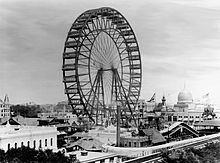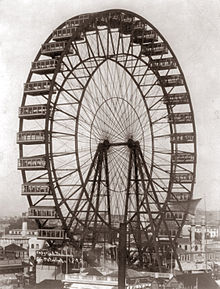- Ferris Wheel
-
This article is about the original 1893 Chicago Ferris Wheel. For the generic term, see Ferris wheel. For other uses, see Ferris wheel (disambiguation).
The original Ferris Wheel, sometimes also referred to as the Chicago Wheel,[1][2][3] was the centerpiece of the 1893 World's Columbian Exposition in Chicago, Illinois.
Intended to rival the 1889 Paris Exposition's 324-metre (1,063 ft) Eiffel Tower, the Ferris Wheel was the Columbian Exposition's largest attraction, with a height of 80.4 metres (264 ft).
The Ferris Wheel was dismantled then rebuilt near Lincoln Park, Chicago, in 1895, and dismantled and rebuilt a third and final time for the 1904 World's Fair in St. Louis, Missouri. It was demolished there in 1906.
Contents
Design and construction
The Ferris Wheel was designed and constructed by George Washington Gale Ferris, Jr., a graduate of Rensselaer Polytechnic Institute. He was a Pittsburgh, Pennsylvania, bridge-builder. He began his career in the railroad industry and then pursued an interest in bridge building. Ferris understood the growing need for structural steel and founded G.W.G. Ferris & Co. in Pittsburgh, a firm that tested and inspected metals for railroads and bridge builders.
The wheel rotated on a 71-ton, 45.5-foot axle comprising what was at that time the world's largest hollow forging, manufactured in Pittsburgh by the Bethlehem Iron Company and weighing 89,320 pounds, together with two 16-foot-diameter (4.9 m) cast-iron spiders weighing 53,031 pounds.[2]
There were 36 passenger cars, each fitted with 40 revolving chairs and able to accommodate up to 60 people, giving a total capacity of 2,160.[1]
On June 9, 1893, the wheel was primed for a test run with great anticipation and no little anxiety. The engine that would activate the wheel was fueled by steam boilers whose underground mains rushed steam to propel the pistons of its thousand-horsepower engines. Upon first seeing the wheel which towered over everything in its vicinity, Julian Hawthorne, son of the author Nathaniel, was amazed that anything of such a size "continues to keep itself erect...it has no visible means of support—none that appear adequate. The spokes look like cobwebs; they are after the fashion of those on the newest make of bicycles".[4]
Both Ferris and his associate W. F. Gronau also recognized the engineering marvel the wheel represented. Would their mathematical calculations and the known qualities of iron and steel they employed conjoin to actualize this unprecedented engineering feat? A giant wheel that would turn slowly and smoothly without structural failure had never before been attempted.[5]
For its inaugural run, no cars had yet been attached. The workmen however, climbed the structure and settled themselves on the spokes to the accompaniment of cheers from an audience of fair employees who had gathered to watch the momentous event. After the wheel had completed its first rotation, Gronau deemed the test a success. "I could have yelled out loud for joy".[6]
Ferris himself had not been able to attend the launching of his invention. That evening Ferris received a telegram: "The last coupling and final adjustment was made and steam turned on at six o’clock this evening one complete revolution of the big wheel was made everything working satisfactory twenty minutes time was taken for the revolution—I congratulate you upon its complete success midway is wildly enthusiastic".[7]
Operation
The Ferris Wheel took 20 minutes to make two revolutions, the first involving six stops to allow passengers to exit and enter and the second a nine-minute non-stop rotation, for which the ticket holder paid 50 cents.
The Ferris Wheel first opened to the public as the centrepiece of the World's Columbian Exposition at Midway Plaisance in Chicago on June 21, 1893, and continued to operate there until after the exposition ended in October 1893. The wheel itself closed in April 1894 and was then dismantled and stored until the following year, when it was rebuilt on Chicago's North Side, near Lincoln Park, next to an exclusive neighborhood. This prompted William D. Boyce, then a local resident, to file a Circuit Court action against the owners of the wheel to have it removed, but without success. It operated there from October 1895 until 1903, when it was again dismantled, then transported by rail to St. Louis for the 1904 World's Fair and finally destroyed there by controlled demolition using dynamite on May 11, 1906.[8]
Coordinates
- 1893–1894 – Midway Plaisance, Chicago: 41°47′13″N 87°35′56″W / 41.786817°N 87.5989187°W [citation needed]
- 1895–1903 – Lincoln Park, Chicago: ?
- 1904–1906 – St. Louis: 38°38′34″N 90°18′04″W / 38.642718°N 90.301051°W [citation needed]
In popular culture
- The hero of Robert Lawson's children's book The Great Wheel is part of the construction crew for the original Chicago Ferris Wheel.
References
 External images
External images
Axle of the 1893 Chicago Ferris Wheel - ^ a b Ferris wheels - an illustrated history, Norman D. Anderson
- ^ a b Hyde Park Historical Society: Chicago's Great Ferris Wheel of 1893, Patrick Meehan
- ^ The Kensington Canal, railways and related developments
- ^ Larson, Erik, The Devil In The White City, Crown Publishers, 2003, p. 258
- ^ Larson, Erik, The Devil In The White City, Crown Publishers, 2003, p. 258-59
- ^ Larson, Erik, The Devil In The White City, Crown Publishers, 2003, p. 260
- ^ Larson, Erik, The Devil In The White City, Crown Publishers, 2003, p. 260
- ^ Ferris, George Washington Gale Jr. biography, Lindsey Ulizio
Preceded by
World's firstWorld's tallest Ferris wheel
1893-1894Succeeded by
Great WheelFerris wheels Fixed Ferris wheels Americas - Canada: Niagara SkyWheel
- USA: Colossus
- the original Ferris Wheel
- SkyWheel (Myrtle Beach)
- Texas Star
Asia - China: Changsha Ferris Wheel
- Harbin Ferris Wheel
- Star of Nanchang
- Suzhou Ferris Wheel
- Tianjin Eye
- Zhengzhou Ferris Wheel
- Japan: Amuran
- Big O
- Cosmo Clock 21
- Daikanransha
- Diamond and Flower Ferris Wheel
- Sky Dream Fukuoka
- Technocosmos / Technostar
- Tempozan Ferris Wheel
- Singapore: Singapore Flyer
Europe - Austria: Wiener Riesenrad
- France: Grande Roue de Paris
- Italy: Eurowheel
- Russia: Moscow-850
- United Kingdom: Great Wheel
- London Eye
Southern Hemisphere - Australia: Southern Star
Variations Transportable Ferris wheels - Individual wheels: Roue de Paris
- Steiger Ferris Wheel
- Installations in Australia: Wheel of Brisbane
- Installations in Malaysia: Eye on Malaysia (Kuala Lumpur & Malacca)
- Installations in United Kingdom & Ireland: Belfast Wheel
- Royal Windsor Wheel
- Wheel of Birmingham
- Wheel of Dublin
- Wheel of Manchester
- Wheel of Sheffield
- Yorkshire Wheel
Double wheels - USA: Giant Wheel
Triple wheels - USA: Sky Whirl
Eccentric wheels - USA: Mickey's Fun Wheel
- Wonder Wheel
Venues hosting other major Ferris wheels Asia - China: Jinjiang Action Park (Shanghai Ferris Wheel)
- Lake Tai (Star of Lake Tai)
- Iran: Mellat Park (Mashhad Ferris Wheel)
- South Korea: Kumdori Land (Polaris Tower)
Europe & Eurasia Proposed Ferris wheels
cancelled proposals, and those for which no completion date has been announced or whose original completion date has already passed, are shown in italicsAmericas - USA: Great Orlando Wheel
- High Roller
- Navy Pier spokeless wheel
- Pepsi Globe
- Skyvue Las Vegas Super Wheel
- Voyager
Asia - Iraq: Baghdad Eye
- Malaysia: Malaysia Eye
- Saudi Arabia: Jeddah Eye
- Thailand: Bangkok Eye
- United Arab Emirates: Great Dubai Wheel
Europe - Germany: Great Berlin Wheel
- Russia: Rus-3000
Related topics Designers, manufacturers, and operators - Allan Herschell Company
- Chance Morgan
- Eli Bridge
- Great Wheel Corporation
- Intamin
- Ronald Bussink (Nauta Bussink)
- World Carnival
Lists - List of amusement parks
- List of amusement rides
- List of Ferris wheels
- List of Ferris wheels in Moscow
- Categories: Amusement rides
- Ferris wheels
- Proposed Ferris wheels
- Ferris wheels @ Wikimedia Commons
Categories:- Ferris wheels
- World's Columbian Exposition
Wikimedia Foundation. 2010.



